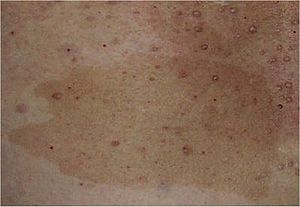Neurofibromatosis type I
| Neurofibromatosis type 1 | |
|---|---|
| Synonyms | von Recklinghausen disease morbus Recklinghausen |
 |
|
| café au lait spot characteristic of NF1. | |
| Classification and external resources | |
| Specialty | Neurosurgery, dermatology |
| ICD-10 | Q85.0 (ILDS Q85.010) |
| ICD-9-CM | 237.71 |
| OMIM | 162200 |
| DiseasesDB | 8937 |
| MedlinePlus | 000847 |
| eMedicine | derm/287 neuro/248 oph/338 radio/474 |
| MeSH | D009456 |
| GeneReviews | |
Neurofibromatosis type I (NF-1) is a complex multi-system human disorder caused by the mutation of a gene on chromosome 17 that is responsible for production of a protein called neurofibromin which is needed for normal function in many human cell types. NF-1 causes tumors along the nervous system which can grow anywhere on the body. NF-1 is one of the most common genetic disorders and is not limited to any person's race or sex. NF-1 is an autosomal dominant disorder which means only side (or allele) of the NF-1 gene requires a mutation for a person to have the symptoms of NF-1. Currently (2015), there are at least 100,000 people in the U.S. and about 15,000 people in the UK who have been diagnosed with NF. Common symptoms of NF-1 include brownish-red spots in the colored part of the eye called Lisch nodules, benign skin tumors called neurofibromas, and larger benign tumors of nerves called plexiform neurofibromas, scoliosis (curvature of the spine), learning disabilities, vision disorders, mental disabilities, multiple café au lait (TCL, name of specifics spots) spots and epilepsy. NF-1 affected individuals also have a much higher rate of cancer and cardiovascular disease than the population in general.
NF-1 is a developmental syndrome caused by germline mutations in neurofibromin, a gene that is involved in the RAS pathway (RASopathy). Due to its rarity and to the fact that genetic diagnosis has been used only in recent years, in the past NF-1 was in some cases confused with another syndrome with vaguely similar symptoms, the Legius syndrome.
NF-1 is an age specific disease; most signs of NF-1 are visible after birth (during infancy), but many symptoms of NF-1 occur as the person ages and has hormonal changes. NF-1 was formerly known as von Recklinghausen disease after the researcher (Friedrich Daniel von Recklinghausen) who first documented the disorder.
The severity of NF-1 varies widely, and little is known about what causes a person to have a more severe or less severe case. Even within the same family (as there is a 50% chance that a parent will pass their condition to their offspring) levels of severity can vary enormously. However, 60% of people with NF-1 have mild cases, with few symptoms that have very little effect in their day-to-day lives. 20% of NF-1 patients have moderate cases, with several symptoms that have little more than cosmetic effects. The other 20% have severe cases with several symptoms that affect the person's quality of life. Even in this last group, symptoms are rarely life-threatening.
...
Wikipedia
